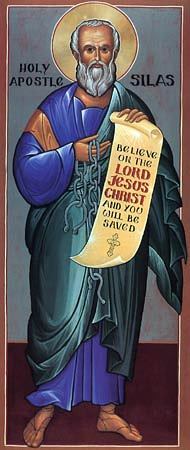Silas facts for kids
Quick facts for kids SaintSilas |
|
|---|---|
 |
|
| Prophet, Disciple, Evangelist, Missionary, Bishop, and Martyr, Companion of Saint Paul | |
| Died | 65–100 AD Macedonia |
| Venerated in | Roman Catholic Church, Eastern Catholic Churches, Eastern Orthodoxy, Oriental Orthodoxy, Anglicanism, and Lutheranism |
| Feast | January 26 (Evangelical Lutheran Church in America, Episcopal Church) February 10 (Lutheran Church–Missouri Synod) July 13 (Roman Martyrology) July 30 (Eastern Orthodoxy) July 13 (Syriac, Malankara Calendars) |
| Attributes | Christian Martyrdom |
Silas (also known as Silvanus) was an important leader in the Early Christian community. He traveled with Paul the Apostle on his second big missionary journey.
Contents
Silas and Silvanus: What's in a Name?
Silas is often thought to be the same person as Silvanus. The name Silvanus is mentioned in several letters written by Paul. Some Bible versions even call him "Silas" in these letters.
Paul, Silas, and Timothy are listed as co-authors of two letters to the Thessalonians. The Second Epistle to the Corinthians also says that Silas preached with Paul and Timothy. The First Epistle of Peter calls Silas a "faithful brother."
In the Acts of the Apostles, he is always called "Silas." However, Paul and the First Epistle of Peter use the Roman name Silvanus. This name means "of the forest." It's possible that "Silvanus" was the Roman version of his original name, "Silas." Or, "Silas" might have been a Greek nickname for "Silvanus."
Silas's Adventures in the Bible
Silas first appears in the Bible in the book of Acts. He and another leader, Judas Barsabbas, were chosen by church elders. They went with Paul and Barnabas to Antioch after an important meeting in Jerusalem. Silas and Judas were known as good leaders and speakers.
Paul's Second Journey
Paul chose Silas to go with him on his second missionary journey. This happened after Paul and Barnabas had a disagreement about whether Mark should join them.
Imprisoned in Philippi
During this journey, Silas and Paul were put in prison in Philippi. But something amazing happened! An earthquake shook the prison, breaking their chains and opening the doors. Because of this story, Silas is sometimes shown in art holding broken chains.
Traveling with Paul
After Philippi, Silas and Timothy traveled with Paul to Thessalonica. There, some people in the synagogues were not friendly to them. These people followed them to Berea, causing trouble for Paul. Paul then went to Athens, while Silas and Timothy stayed behind for a bit. They later met up with Paul in Corinth.
Silas is mentioned in the greetings of the letters to the Thessalonians. He is also mentioned in 2 Corinthians. This makes sense because he was with Paul when these cities were visited. He also appears at the end of 1 Peter, where Peter calls him "a faithful brother."
Honoring Saint Silas
Saint Silas is honored by many Christian churches.
- The Evangelical Lutheran Church in America and the Episcopal Church (United States) celebrate him on January 26 with Timothy and Titus.
- The Roman Catholic Church celebrates him on July 13.
- The Lutheran Church–Missouri Synod honors him on February 10.
- The Eastern Orthodox Church celebrates him on July 30, along with other apostles. They also honor him on January 4th with all the apostles.
See also
 In Spanish: Silas para niños
In Spanish: Silas para niños

